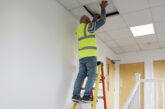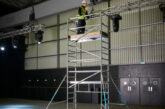
Kris Hallee, Head of Product Development at WernerCo, shares his top 5 tips on keeping safe while working at height in winter
Falls from height remain the leading cause of workplace accidents, with an estimated 30,000 non-fatal injuries occurring each year. Throughout the winter months, harsh weather elements and low lighting conditions pose an additional health and safety threat and can increase the risk of injury. As these conditions can affect a worker’s ability to carry out a job safely, it is vital to ensure that necessary precautions are taken to prevent hazards.
Wearing the correct clothing is paramount for safe working throughout the colder months. As a first defense against the cold, additional winter layers must keep wearers warm and dry, while at the same time, still allow free movement and not impair the efficiency of PPE.
Added winds can contribute to freezing temperatures, which often make working from height much colder than on the ground. Adopting the ‘3 layer’ garment principle is an effective way to remain warm and dry. A base layer should be moisture-wicking and transport sweat away from the skin, while a mid-layer of a thick jumper or fleece will insulate heat to keep you warm; and a third outer layer of a waterproof coat will shield you from the wind and rain.
Additionally, it is advised to wear enough layers of clothing to protect ears, face hands and feet with appropriate hats, face coverings, gloves and boots. As an additional safety measure, consideration should be given towards purchasing a reflective outer layer which will ensure that workers remain clearly visible in low-light conditions.
It is essential that any additional clothing such as gloves, headwear or outer layers do not impact visibility, grip, hearing or movement, or impair the fit of other protective clothing worn while on a job, which could result in accidents occurring.
2. Step up with risk assessments
The Work at Height Regulations 2005 highlight that risk assessments should be taken into account when organising and planning work, and identifying any precautions required. When the colder weather can affect both the functionality of equipment and the safety of working conditions, regular safety checks should be stepped up in the winter months to try and negate additional risks.
Falls from height could come from hazards such as water leaks that could turn into ice; wet, decaying leaves; slippery wet or icy surfaces; waterlogged or slippery ground which could destabilise access equipment; and windy, wet or snowy weather which could affect safe working conditions, and subsequently the worker’s ability to carrying out jobs safely.
In addition, regular checks on ladders and structures must be undertaken to check for problems caused by low temperatures. It remains imperative to be aware of what defaults to check for, and what steps should be taken if a problem should arise. Signs to look out for include movement from original fixing positions; frozen, damaged, loose or missing components such as screws and fixing bolts; and rust and corrosion.
On top of regular risk assessments, workers must ensure that ladders, structures and equipment are both inspected and tested every 12 months. Doing this prior to the winter months will ensure businesses are legally compliant and that the equipment is safe to use throughout the colder weather.
3. Implement control measures
Once a risk assessment has been undertaken, workers should always ensure that the appropriate measures are implemented to enable safe working.
If it is too dark on site to be able to clearly identify hazards, visibility will need to be improved by adding more lighting to the area. While snow is clearly visible, ice and wet surfaces may not be. Depending on the job, utilise slip-free solutions such as grates and non-slip surfaces to establish safe working spaces and pathways to minimise the risk of accidents. In addition, depending on the job, always take extra precautions to maintain maximum safety when working at height.
When equipment may be damaged from repeated freezing and thawing, which can cause it to weaken, it is vital to keep it protected. Where possible, it is always good to store equipment inside or under covers when not in use to minimise this risk. Remove as much ice as possible if it freezes over and avoid drying it with a heater. Regularly check over the structures and equipment in the working area after any changes to the weather, particularly if using an access tower or scaffolding.
4. Refresh Health and Safety training
Having the correct training is vital for ensuring workers understand health and safety procedures and work according to the current requirements, know what risks to look out for, and how to act in the event of an accident. It is recommended that a training refresh is undertaken at least every six months, so doing this ahead of the winter months will ensure that workers can carry out work safely and limit the risk of serious injury if a fall should occur.
Cold weather can have adverse effects on the body, which not only increases the risk of accidents, but also causes conditions such as cold stress, frostbite and hypothermia. All workers on site should be trained to spot the symptoms of these conditions in both themselves and others, which can include shivering, confusion, loss of coordination and slurred speech.
5. Be flexible
When the winter weather can be unpredictable, it remains essential to be both prepared and flexible to work around conditions.
Always check the weather ahead of a job and monitor it closely. If it shows signs of posing a threat to health and safety, always postpone the job and continue when it is safe to do so and does not compromise safety.
Where possible, limit time spent outdoors and schedule certain tasks for certain hours of the day where there is better lighting and to avoid any potential wind, rain or snow.
Working outside in cold weather requires more energy than working in warmer conditions, meaning workers are more likely to tire quicker than usual, which could affect concentration and pose a risk to slips and falls. Introduce more frequent breaks and allow extra time to rest, warm up and change into dry clothing if needed, and that where possible, jobs are rotated between workers.
Working from height regularly involves working outdoors, where exposure to the weather elements is often unavoidable. However, with additional safety measures and adequate training to ensure workers can both prevent hazards and act appropriately when accidents occur, proactive steps can be taken to maintaining a safe working practice while working at height and help to reduce the number of accidents and fatalities reported each year.
To find out more information on the range of access solutions, click here
For more on WernerCo training, click here








